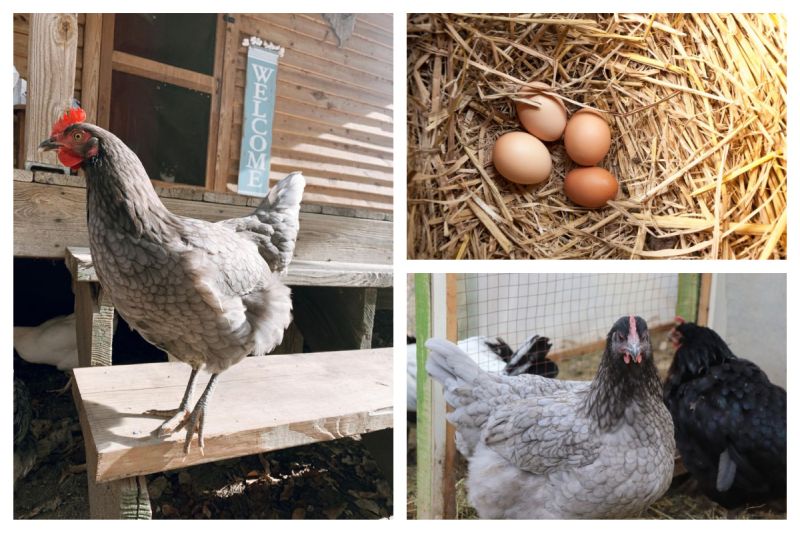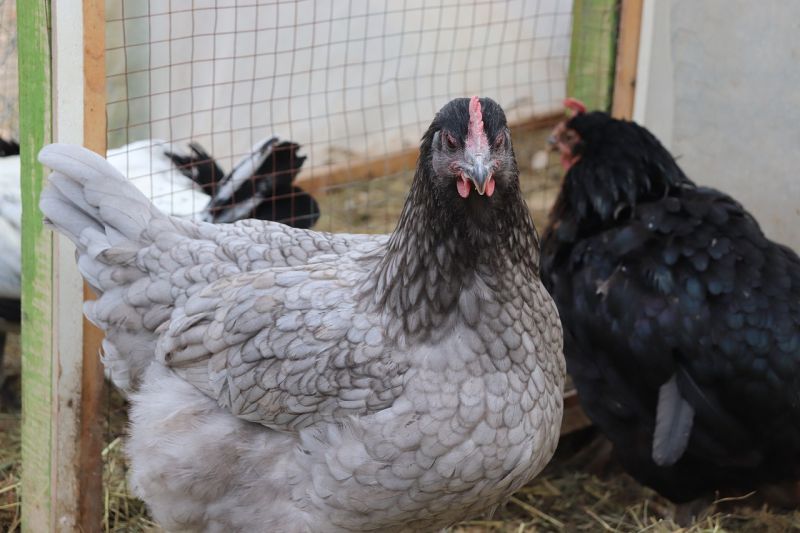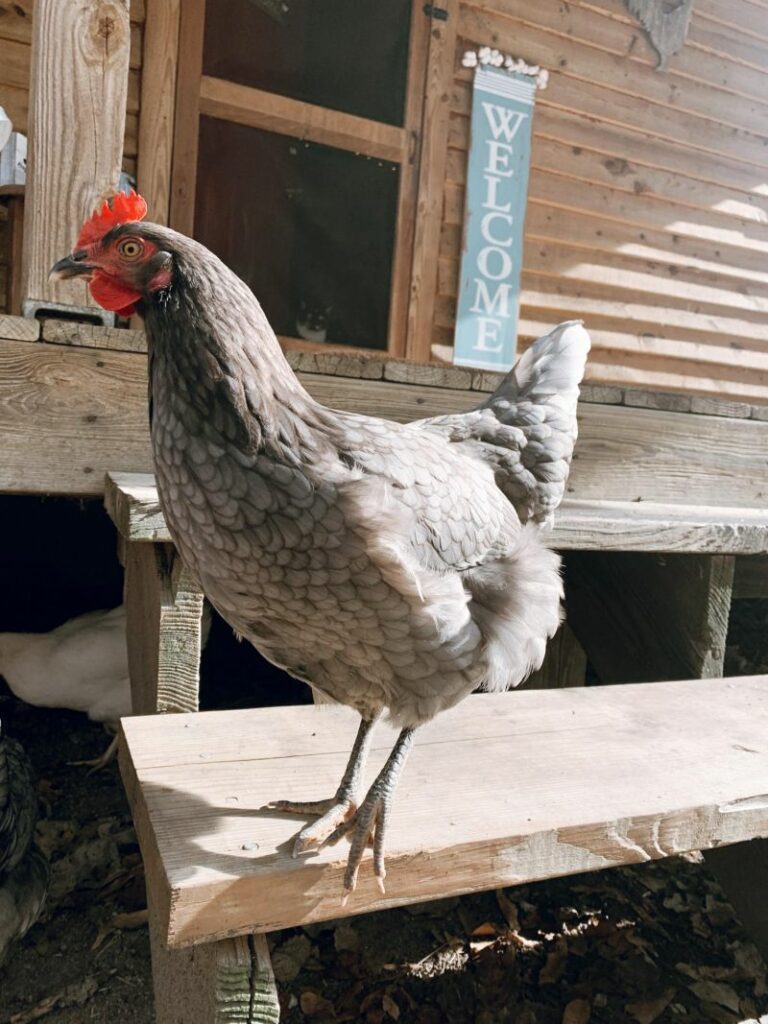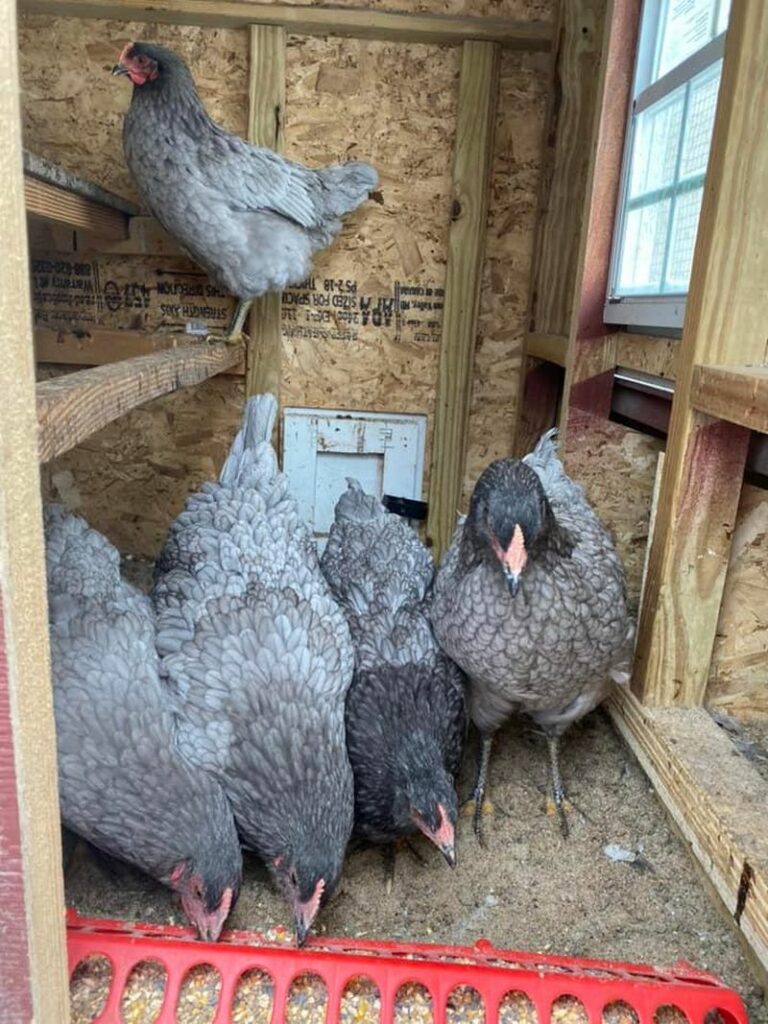The Sapphire Gem chicken is gaining popularity due to its mesmerizing appearance. Yet, these birds are good for more than just looks. They’re also easy to care for and have great egg production.
Sapphire Gems are good egg layers with an easygoing temperament. So, let’s see if they’re the right chickens for you. This article will cover topics like “what color eggs do sapphire gem chickens lay?” and “how to care for a Sapphire hen.“

Sapphire Gem Chicken Overview
Before we look at the details of this breed, let’s look at some of the important characteristics of a Sapphire Gem.
| Lifespan | 5 – 10 years |
| Weight | 4 – 7 pounds |
| Appearance | Blue or lavender feathers |
| Egg Production | 4 – 6 eggs per week, 280 – 300 per year |
| Egg Color | Brown |
| Good for Beginners? | Yes |
| Minimum Coop Size | 4 square feet per chicken |
| Price | $3 to $5 per chick |
History

Not much is known about Sapphire Gem chickens since they’re a newer breed. The American Poultry Association doesn’t even recognize them yet. They are thought to have been first bred in the Czech Republic.
Some people refer to this breed as the Blue Sapphire Plymouth Rock or a Sapphire Blue Plymouth Rock because they’re likely a mix between a Blue Plymouth Rock and a Barred Plymouth Rock. That’s why they have such a unique look with similar egg-laying abilities to other Plymouth Rocks. The Barred and Blue Plymouth Rock chickens are just color varieties of the breed.
Appearance
Since these chickens are an “unofficial breed,” they don’t have a breed standard. Yet, here’s what you can expect them to look like at each stage in life, including the Sapphire Gem egg color.
Sapphire Gem Chicken Egg Color
Sapphire Gem chicken eggs are brown. They’re larger than the average egg, and despite popular belief, the Sapphire Gem eggs are never blue like the bird’s feathers. If you’re looking for a chicken that produces more colorful eggs, you may want to check out a different breed.
Chick and Pullet Appearance
The color of chicks and pullets may vary. Some may be more blue or black while others are closer to gray or lavender. You can usually tell the sex of the chicks not long after they hatch. Like adults, Sapphire Gem chicks and Sapphire Gem pullets have a white spot on their heads as a male or a necklace of gold or gray spots as a female.
What Color is a Sapphire Gem Adult?
If you look at pictures of sapphire gem chickens, you’ll see that both sexes have blue or lavender feathers. However, hens and roosters have slightly different appearances. Roosters can be distinguished by their blue feathers and a white dot on their head or wings. Then, females have blue feathers with a patch of gray or gold feathers on their necks.
These birds have a single comb, and their posture is more upright than most chicken breeds. Sometimes, their feathers might look more lavender than blue.
Size and Weight
These birds are medium-sized when they’re full-grown. A Sapphire Gem hen will usually weigh between four and six pounds while a Sapphire Gem rooster will be larger, between five and seven pounds.
Personality

Sapphire Gems are considered great for beginners due to their friendly and easy-going temperaments. They’re highly adaptable, making them suitable for all types of environments.
These chickens tend to be calm and docile, making them well-behaved even around children. They’re often kept as pets instead of livestock due to their willingness to cuddle and be held. They have one of the best chicken breed temperaments overall.
Broodiness
Sapphire Gem chickens aren’t known to be broody. Thus, it’s easy for novice chicken keepers to raise them for eggs without running into complications. However, you’ll need to learn how to hatch your own chicken eggs first.
Noise Levels
Luckily, these chickens are rarely noisy and usually don’t make much sound at all. However, if you have a Sapphire Gem chicken rooster, then you can expect some sounds early in the morning. A Sapphire hen might chatter a little bit during the day, but not much beyond that.
Do Sapphire Gems Get Along with Other Animals?
Sapphire Gem chickens get along with most animals. So, they will get along with other chicken breeds well, even if kept in the same flock. Larger animals might be scary to them though since they could resemble predators.
Here are some other friendly chickens that you may be able to house with this breed:
- Plymouth Rock
- Silkie
- Buff Orpington
- Speckled Sussex
- Cochin
Sapphire Chicken Care Requirements

Caring for a Sapphire Gem isn’t much different than looking after similar breeds. They’re a great beginner breed, but they still require research in advance like any other chicken. So, what should you know before adding these chickens to your flock?
Diet
At every life stage, your chickens should receive a proper feed. Sapphire Gem baby chicks need more protein to support their growing bodies. So, you can start them off with a chicken feed that has 18% to 24% protein. As they get older, you can decrease the amount of protein slightly.
Then, when a Sapphire Gem hen starts laying eggs, it’s recommended that you give them an adult feed with a little extra protein and calcium. If the hens consume extra protein and nutrients, the Sapphire chicken eggs will have strong, healthy shells. There are plenty of feeds available made specifically for hens laying eggs.
Habitat Setup
In the coop, these birds require a minimum of four square feet per bird. However, they don’t like to be confined to a small area, so more space is better.
These birds do best if given free-range time. They are great at foraging, so they will find extra nutrients as they explore. They are more observant and alert than chickens, so they are great at avoiding predators.
Letting chickens roam is safe because chickens rarely run away unless they feel threatened. If they’re provided their basic necessities like food and shelter, they’ll return to their comfortable coop at night. It’s best to keep the chickens in their coop at night since that’s when predators are most active.
Temperature
The blue Sapphire Gem chicken can do well in all types of climates. Yet, like all birds, you’ll need to take extra precautions during extreme weather.
Since Sapphire Gems are single-comb chickens, their biggest concern in the winter is frostbite. Providing them with plenty of shelter can help keep them warm when the weather dips below freezing. Purchasing a coop heater is another way to protect them.
In the summer, you should have plenty of ways for your birds to cool off. Always provide cool water to your chickens. You can also give them cold snacks, such as frozen fruits, to help with hydration. Their coop should be well-ventilated with lots of shade outside. Adding fans to your Sapphire blue chicken enclosure can be beneficial in extreme heat.
As long as you take extra precautions to keep your blue Sapphire chicken safe, they’ll be able to handle all types of weather.
Health Concerns
A Sapphire Gem is considered a hardy bird with minimal health problems. So, their main concerns are the same as with any other chicken breed.
The most common health concern for chickens is parasites. Lice, mites, and worms are a threat to all breeds if not properly cared for. Keeping your coop clean and replacing their food and water regularly is a great way to keep pests away from your flock.
Keeping the chicken enclosure clean can also prevent your birds from catching various chicken diseases. Fowl pox, coccidiosis, and avian influenza are just a few issues your chickens could face if you’re not careful. However, these issues are not specific to Sapphire Gems.
To keep your chickens healthy overall, feed them a beneficial diet and protect them from extreme weather. Taking them in for regular vet checkups is another way to stay on top of their health and well-being.
How to Breed Sapphire Gem Chickens

Chickens are easy to breed because you don’t need to interfere at all. Simply introduce your hens to a Sapphire Gem rooster, and then they’ll start breeding. Since these birds are a cross between two types of Plymouth Rocks, you might not get Sapphire Gem chicks every time you breed them.
You don’t have to breed these chickens if you don’t want to. Many keepers care for the hens to get eggs to sell and eat. So, what is this breed’s egg production like?
When Do Sapphire Gems Start Laying?
Sapphire Gem chickens tend to mature faster than most chickens. So, they could start laying eggs as early as four to six months old. The Sapphire Gem chicken egg size is usually medium to large.
Sapphire Gem Chicken Egg Production
These chickens usually lay between four and six eggs per week. That means they’ll usually end up with 280 to 300 eggs annually. Like all breeds, they lay the most eggs within their first few years, and then they start laying less as they age.
Since these chickens lay so many eggs, you might want to check out some egg recipes to try.
Frequently Asked Questions
If you’re considering caring for one of these birds, you may have some questions. So, here are some things new chicken keepers commonly wonder.
How Long Do Sapphire Gem Chickens Live?
These chickens can live anywhere from 5 to 10 years. This lifespan is the same as the average lifespan for chickens.
Their living conditions and care will greatly affect how long they live. As they get older, they may not lay as many eggs.
Are Sapphire Gems Good Meat Chickens?
While these chickens can be used for meat, it’s not common. Sapphire Gems were bred as egg layers, so using them for meat will prevent you from getting a plentiful amount of eggs from these birds.
Where Can You Buy Sapphire Gem Chickens?
There are plenty of breeders that sell this breed. Look for a breeder that prioritizes the health of the birds to ensure that they’ll live long and produce healthy eggs. One of these chicks is usually between $3 and $5.
Are Sapphire Gem Chickens Right for You?
It’s no surprise that these chickens are a beautiful breed. These birds have unique blue feathers that make them desirable to chicken keepers. Yet, you need to consider much more than just their appearance if you want to raise them.
If you’re looking for a beginner-friendly bird that’s a good egg-layer, then this breed is likely a good match for you. Just make sure you have plenty of space available for them, and be willing to protect them during extreme weather conditions. If you follow those care requirements, you’ll have happy birds and healthy eggs for years to come.